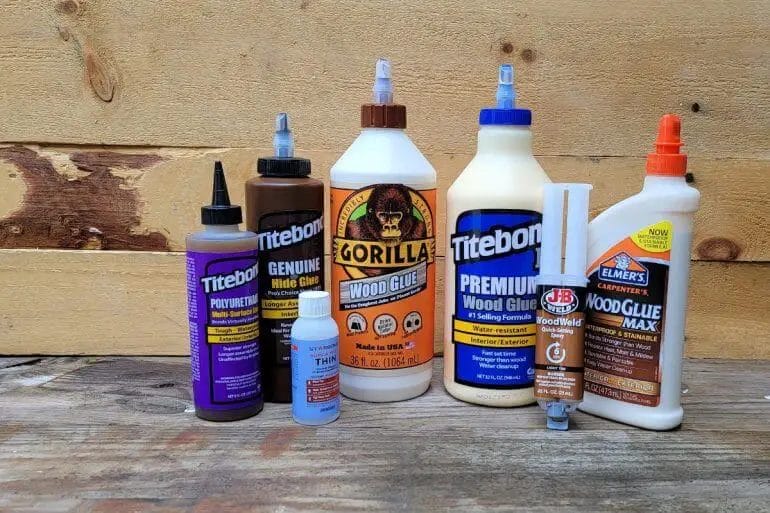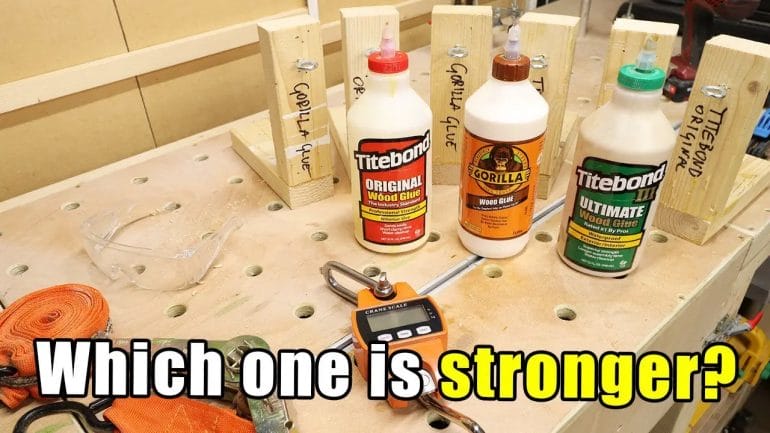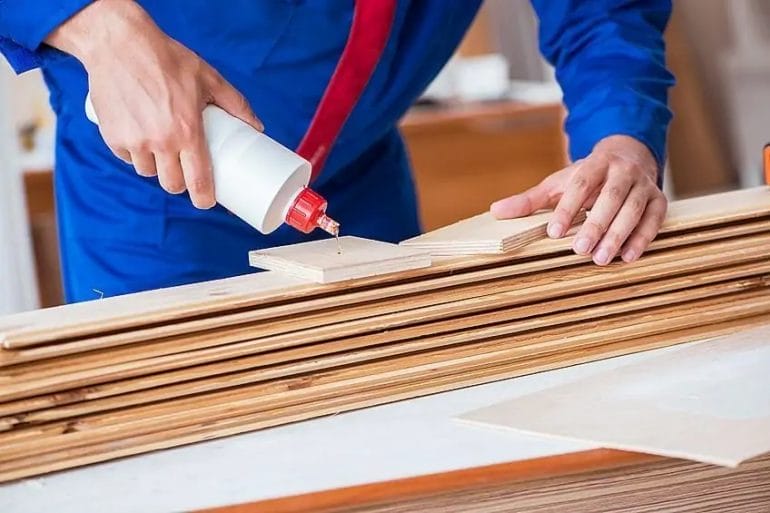Wood glue is specifically formulated to bond wood surfaces together, but it is not designed for use on plastic materials. The chemical composition and adhesive properties of wood glue are not compatible with plastic, making it ineffective for creating a strong and durable bond between plastic surfaces.
If you need to bond plastic materials, it is recommended to use a specialized plastic adhesive or epoxy that is designed to adhere to plastic surfaces. These adhesives provide a stronger bond, ensuring the longevity and durability of the plastic joint.

Using the right adhesive for the specific materials you are working with is crucial to achieve a successful and long-lasting bond. Always refer to the manufacturer’s instructions and choose the appropriate adhesive for the materials you are working with to ensure the best results.

Exploring the Compatibility of Wood Glue with Plastic Surfaces
When it comes to woodworking projects, wood glue is a staple adhesive that craftsmen rely on for its strong bond and versatility. However, there may be occasions where you want to join wood and plastic surfaces together. In such cases, it’s essential to understand the compatibility of wood glue with plastic surfaces to ensure a successful and durable bond.
Wood glue is specifically formulated to bond porous materials, like wood, by penetrating the fibers and creating a strong connection. Plastic, on the other hand, is non-porous and typically requires adhesives that have a different chemical composition to form a reliable bond. This difference in material properties poses a challenge when trying to glue wood and plastic surfaces together.
Factors to Consider
Before attempting to bond wood and plastic, there are several factors to consider:
- Types of Plastic: Different types of plastic have varying chemical compositions, which can affect the adhesive properties. It’s crucial to identify the type of plastic you’re working with to choose the appropriate glue.
- Surface Preparation: Both the wood and plastic surfaces need to be clean and free from any contaminants that could compromise the bond. Sanding or roughening the surfaces can also improve the adhesive’s ability to adhere.
- Adhesive Selection: Not all wood glues are suitable for bonding plastic. Specialized adhesives, such as epoxy or cyanoacrylate (super glue), are often recommended for joining wood and plastic surfaces.
Recommended Adhesives for Wood and Plastic Bonding
While wood glue may not be the ideal choice for bonding wood and plastic surfaces, there are alternative adhesives that offer better compatibility:
- Epoxy: Epoxy adhesives are known for their excellent bonding strength and versatility. They can bond a wide range of materials, including wood and plastic. Epoxy typically comes in two parts that need to be mixed before application, ensuring a strong and durable bond.
- Cyanoacrylate (Super Glue): Cyanoacrylate adhesives, commonly known as super glue, also provide a reliable bond between wood and plastic surfaces. They cure quickly and create a strong connection. However, it’s important to choose a cyanoacrylate glue specifically designed for plastics.
- Polyurethane Adhesives: Polyurethane adhesives are another option for bonding wood and plastic. They have good flexibility and can withstand changes in temperature and humidity, making them suitable for outdoor applications.
Application Techniques
Regardless of the adhesive chosen, proper application techniques are crucial for achieving a successful bond between wood and plastic surfaces:
- Apply Adhesive Evenly: Ensure that the adhesive is spread evenly on both the wood and plastic surfaces. This will help maximize contact and bond strength.
- Use Clamps or Pressure: Applying pressure using clamps or heavy objects can help create a tight bond between the wood and plastic surfaces. It’s important to follow the adhesive manufacturer’s instructions regarding clamping time.
- Allow Sufficient Drying Time: Give the adhesive enough time to fully cure before subjecting the bonded surfaces to stress or load. This will ensure a strong and durable bond.
Summary
While wood glue is not typically compatible with plastic surfaces, there are alternative adhesives available that can effectively bond wood and plastic together. Epoxy, cyanoacrylate (super glue), and polyurethane adhesives are commonly used for joining these materials. Proper surface preparation and application techniques are crucial for achieving a strong and durable bond. By considering the specific type of plastic, choosing the appropriate adhesive, and following proper application methods, you can successfully join wood and plastic surfaces for your woodworking projects.

Tips and Techniques for Using Wood Glue on Plastic Materials
Using wood glue on plastic materials can be a tricky process, as the two materials have different properties and may not bond easily. However, with the right techniques and precautions, it is possible to achieve a strong and durable bond. In this section, we will discuss some tips and techniques that can help you successfully use wood glue on plastic materials.
1. Choose the Right Type of Wood Glue
Not all wood glues are suitable for bonding plastic materials. It is important to choose a wood glue that is specifically designed for plastic bonding. Look for glues that are labeled as “plastic compatible” or “multi-purpose,” as these are more likely to work effectively on plastic materials.
2. Clean and Prepare the Surfaces
Before applying the wood glue, it is crucial to clean and prepare the surfaces that will be bonded. Use a mild detergent and warm water to clean the plastic surface, removing any dirt, dust, or grease. For optimal adhesion, lightly sand the plastic surface with fine-grit sandpaper to create a rougher texture.
3. Apply the Glue Properly
When applying the wood glue, make sure to use the right amount. Apply a thin, even layer of glue to the plastic surface using a brush or a small applicator. Be careful not to apply too much glue, as this can lead to excessive drying time and weak bond strength. Follow the instructions provided by the manufacturer for the recommended amount of glue to be used.
4. Allow Sufficient Drying Time
After applying the wood glue, it is important to allow sufficient drying time for the bond to strengthen. Check the instructions on the glue bottle for the recommended drying time. Avoid handling or putting any pressure on the bonded surfaces until the glue has completely dried.
5. Use Clamps or Weights
To ensure a strong and secure bond, consider using clamps or weights to hold the bonded surfaces together while the glue is drying. This will help to prevent any movement of the materials and ensure a tight bond. Use caution not to apply too much pressure, as this can cause the plastic to deform or crack.
6. Test the Bond Strength
Before using the bonded plastic materials in any critical applications, it is recommended to test the bond strength. Apply pressure or stress to the bond and check for any signs of weakness or failure. If the bond does not hold up to the desired strength, you may need to reapply the glue or consider using a different adhesive.
7. Consider Using a Plastic Primer
If you are having difficulty achieving a strong bond with wood glue alone, consider using a plastic primer. A plastic primer can help to enhance the adhesion between the wood glue and the plastic surface, resulting in a stronger bond. Apply the plastic primer according to the manufacturer’s instructions before applying the wood glue.
8. Store and Handle the Glue Properly
To ensure the longevity and effectiveness of the wood glue, it is important to store and handle it properly. Close the glue container tightly after each use and store it in a cool, dry place. Avoid exposing the glue to extreme temperatures or moisture, as this can affect its adhesive properties.
9. Consider Using a Polyurethane Adhesive
If you are still experiencing difficulties with bonding wood and plastic materials, you may want to consider using a polyurethane adhesive. Polyurethane adhesives are known for their excellent bonding strength and versatility. They can provide a reliable bond between wood and plastic materials, even in challenging applications.
10. Consult the Manufacturer’s Recommendations
Each wood glue product may have specific recommendations and guidelines for bonding plastic materials. It is important to consult the manufacturer’s instructions and follow their recommendations for the best results. They may provide additional tips and techniques that are specific to their product.
By following these tips and techniques, you can increase the chances of successfully bonding wood and plastic materials using wood glue. Remember to choose the right type of glue, properly prepare the surfaces, apply the glue correctly, allow sufficient drying time, and consider using additional aids such as clamps or weights. With proper care and attention, you can achieve a strong and durable bond that will withstand the test of time.

Common Mistakes to Avoid When Using Wood Glue on Plastic
Wood glue is a popular adhesive used for joining wood pieces together. However, if you are planning to use wood glue on plastic, there are certain mistakes you should avoid to ensure a successful bond. Using the wrong type of glue or not preparing the surfaces properly can result in weak bonds or even damage to the plastic. In this section, we will discuss some common mistakes to avoid when using wood glue on plastic.
1. Using the Wrong Type of Glue
One of the most common mistakes is using the wrong type of wood glue for plastic. Wood glue is designed specifically for bonding wood fibers together, and it may not work effectively on plastic surfaces. When choosing a glue for plastic, make sure to use a product that is specifically formulated for plastic bonding, such as a cyanoacrylate adhesive or an epoxy resin.
2. Not Preparing the Surfaces
Proper surface preparation is essential for creating a strong bond between wood glue and plastic. The surfaces should be clean, dry, and free from any dust, dirt, or grease. It is recommended to use a mild detergent or rubbing alcohol to clean the plastic surface before applying the glue. Additionally, roughening the plastic surface with sandpaper can improve the adhesive bond.
3. Applying Too Much Glue
Another common mistake is applying too much glue, thinking that it will result in a stronger bond. However, applying excessive amounts of glue can lead to messy applications and may even weaken the bond. It is important to follow the manufacturer’s instructions and apply the glue in a thin, even layer. This allows for better penetration of the adhesive into the plastic surface and ensures a stronger bond.
4. Rushing the Bonding Process
Patience is key when working with wood glue on plastic. Rushing the bonding process can lead to weak bonds that easily break or peel off. After applying the glue, it is important to allow sufficient time for it to fully cure. Follow the manufacturer’s instructions regarding the drying and curing time, and avoid applying any stress or pressure to the bonded surfaces until the glue has completely cured.
5. Ignoring Temperature and Humidity Conditions
The temperature and humidity conditions can significantly impact the bonding process when using wood glue on plastic. Extreme temperatures or high humidity can affect the adhesive properties of the glue and result in weaker bonds. It is important to read the instructions on the glue packaging and ensure that the glue is applied within the recommended temperature and humidity range.
6. Not Testing the Bond
Before relying on the bond for any load-bearing applications, it is crucial to test the strength of the bond. Apply a small amount of force or stress to the bonded surfaces and check if the bond holds up. If the bond fails, you may need to reapply the glue or consider using a different adhesive that is better suited for bonding wood and plastic.
In summary, using wood glue on plastic requires careful attention to detail to achieve a strong and durable bond. By avoiding these common mistakes, such as using the wrong type of glue, not preparing the surfaces properly, applying too much glue, rushing the bonding process, ignoring temperature and humidity conditions, and not testing the bond, you can ensure a successful adhesive bond between wood and plastic surfaces.
Alternatives to Wood Glue for Joining Plastic Surfaces
Wood glue is a popular adhesive used for joining wood surfaces together. However, when it comes to joining plastic surfaces, wood glue may not be the best option. Plastic surfaces require a special type of adhesive that can effectively bond them together. In this section, we will explore some alternatives to wood glue for joining plastic surfaces.
Epoxy
Epoxy is a versatile adhesive that is commonly used for bonding plastic surfaces together. It consists of two components – resin and hardener – which need to be mixed together in the right proportions before application. Epoxy provides a strong and durable bond, making it suitable for various plastic applications.
One advantage of epoxy is its ability to bond different types of plastics, including polyethylene, polypropylene, PVC, and ABS. However, it is important to note that not all epoxies are suitable for all types of plastics. It is recommended to check the manufacturer’s guidelines to ensure compatibility.
Cyanoacrylate (Super Glue)
Cyanoacrylate, commonly known as super glue, is another popular adhesive for joining plastic surfaces. It is a fast-acting adhesive that forms a strong bond within seconds of application. Super glue works well on a variety of plastics, including acrylic, polycarbonate, and nylon.
When using super glue, it is important to ensure that the surfaces are clean and dry for optimal bonding. It is also advisable to use it in a well-ventilated area and avoid contact with skin or eyes as it can cause irritation.
Plastic Welding
Plastic welding is a technique used to join plastic surfaces together by melting them and then allowing them to cool and solidify. It is commonly used for joining thermoplastics such as polypropylene and PVC. This method requires a plastic welding machine or a soldering iron specifically designed for plastic welding.
Plastic welding provides a strong and durable bond, especially for larger plastic surfaces or when a seamless joint is desired. However, it requires experience and skill to ensure proper melting and bonding of the plastic surfaces.
Adhesive Tapes
Adhesive tapes can also be used to join plastic surfaces together. There are specialized tapes available that are designed for bonding plastics. These tapes typically have a strong adhesive backing that provides a secure bond.
One advantage of adhesive tapes is that they are easy to apply and do not require any additional tools or equipment. They can be used for both temporary and permanent bonding applications. However, the strength and durability of the bond may vary depending on the type and quality of the adhesive tape.
Hot Glue
Hot glue, also known as hot melt adhesive, is a versatile adhesive that can be used for joining plastic surfaces. It is applied using a hot glue gun, which melts the adhesive and allows it to bond the plastic surfaces together when it solidifies.
Hot glue is particularly useful for bonding lightweight plastics and for temporary bonding applications. However, it may not provide a strong and durable bond for heavy-duty or long-term use.
Summary
When it comes to joining plastic surfaces, wood glue may not be the most effective option. Thankfully, there are several alternatives available, such as epoxy, cyanoacrylate (super glue), plastic welding, adhesive tapes, and hot glue. Each of these alternatives has its own advantages and considerations, so it is important to choose the most appropriate adhesive for your specific plastic bonding needs. Remember to always follow the instructions provided by the manufacturer for optimal bonding results.
FAQs
Can wood glue be used on plastic?
No, wood glue is specifically designed for bonding wood surfaces and may not provide a strong bond on plastic. It is recommended to use adhesives that are specifically formulated for plastic bonding, such as cyanoacrylate (super glue) or epoxy.
Conclusion:
In conclusion, while wood glue is specifically formulated for bonding wood surfaces, it is not recommended for use on plastic. Plastic surfaces require a different type of adhesive that is designed to create a strong bond between plastic materials. Attempting to use wood glue on plastic may result in poor adhesion and an unreliable bond. It is important to choose the correct adhesive for the specific materials being bonded to ensure a durable and long-lasting connection. Always follow the manufacturer’s instructions and consult with professionals or experts if unsure about the suitable adhesive for your project.
